Grade I listed churches in Lancashire facts for kids
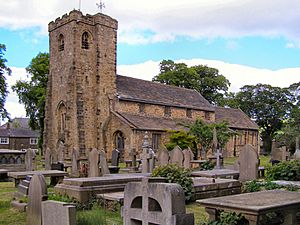
Lancashire is a county in the North West of England. Its borders have changed over the years. In 1974, some parts of the historic county became part of Greater Manchester, Merseyside, and other nearby counties. Today, the area known as the ceremonial county of Lancashire includes the local authorities of Blackburn with Darwen and Blackpool.
In England, some buildings are so special they are given "listed building" status. This means they are officially recognized as nationally important and are protected from being changed or knocked down. The most important buildings are called "Grade I listed." This means they have "exceptional interest" and are sometimes considered important to the whole world. Only a tiny number of listed buildings get this top grade.
This list shows all the Grade I listed churches and chapels in Lancashire.
Many of these churches are very old, with some parts dating back to the Anglo-Saxon period (before 1066). You can see ancient stonework from this time at St Peter's Church, Heysham and the ruins of St Patrick's Chapel, Heysham. Other churches have features from the Norman era, which came after the Anglo-Saxons. However, most of the churches on this list were built in the Gothic style, known for its pointed arches and tall windows.
During the 19th century, many of these churches were restored or had new sections added in a style called Gothic Revival, which copied the medieval Gothic look. Most of the churches are Anglican (part of the Church of England). Two are Roman Catholic churches built in the 19th century: Pleasington Priory and the Church of St. Walburge, Preston. The churches were built with local stone, mainly sandstone and limestone, which was found in the area.
Famous Churches of Lancashire
| Name | Location | Photograph | Interesting Facts |
|---|---|---|---|
| St Michael | Aughton 53°32′31″N 2°55′11″W / 53.5419°N 2.9198°W |
 |
Most of this church was built in the 1300s, but it has even older parts from the 1100s and 1200s. It has a steeple with a round tower that becomes an eight-sided spire. Inside, you can see part of an Anglo-Saxon cross-head that is over 1,100 years old, dating back to around the year 850. |
| St Mary-le-Ghyll | Barnoldswick 53°55′42″N 2°09′52″W / 53.9282°N 2.1644°W |
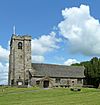 |
This church dates from the 1400s and 1500s, with its tower built in 1524. Inside, it has a rare set of box pews, which are like little wooden rooms for families to sit in. Most of these pews are from the 1600s. It also has a complete three-decker pulpit from the 1600s. |
| St Peter and St Paul | Bolton-by-Bowland 53°56′25″N 2°19′36″W / 53.9402°N 2.3267°W |
 |
Built in the 1400s, this church has tops that look like a castle's walls. A special memorial inside is dedicated to Sir Ralph Pudsay, a local lord. The carving shows him, his three wives, and all of his 25 children. |
| St Michael | Bracewell 53°55′55″N 2°12′36″W / 53.9320°N 2.2101°W |
 |
This church is mostly from the 1400s or early 1500s, but it has older features like a Norman doorway and arch. The font where babies are baptized is also Norman. The pews were made by the famous furniture maker Robert "Mouseman" Thompson, who was known for carving a mouse into his work. |
| St Helen | Churchtown 53°52′44″N 2°47′24″W / 53.8788°N 2.7900°W |
 |
The oldest parts of St Helen's are from the 1200s. The church has a tower with a castle-like top and a small building that was used to store a hearse. Inside, there are wall paintings from the 1400s and 1600s that were restored in 1986. |
| St Bartholomew | Colne 53°51′26″N 2°10′13″W / 53.8572°N 2.1703°W |
 |
This church is mainly from the early 1500s, but some parts are from the 1200s. It was built in the Perpendicular Gothic style. During a restoration in 1889–91, a single side passage (aisle) was replaced with a double one. Inside, there are memorials and brass plaques from the 1600s and later. |
| All Hallows | Great Mitton 53°50′46″N 2°26′02″W / 53.8462°N 2.4339°W |
 |
All Hallows dates from the 1200s. A chapel added in the late 1500s contains impressive tombs for the Shireburn family, some with carved figures (effigies) on top. The church also has a screen made with medieval woodwork. |
| St John the Evangelist | Gressingham 54°07′24″N 2°39′20″W / 54.1233°N 2.6556°W |
 |
This church was partly rebuilt in 1734 but still has parts from the 1100s. It has a Norman doorway and several stones with Anglo-Saxon carvings. The pulpit is dated 1714, and the church has old-fashioned box pews. |
| St Cuthbert | Halsall 53°35′07″N 2°57′08″W / 53.5854°N 2.9523°W |
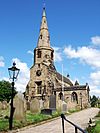 |
The main part of the church is from the 1300s, and the steeple is from the early 1400s. The steeple is interesting because it starts as a square tower, becomes an eight-sided section, and then has a spire on top. Some of the choir stalls have misericords, which are small shelves for clergy to lean on during long services. |
| St Patrick's Chapel | Heysham 54°02′51″N 2°54′10″W / 54.0475°N 2.9027°W |
 |
This is a ruined chapel from the 700s or 800s. Only some of the walls are still standing. Near the ruins are ancient graves cut directly into the rock. These unique graves are also listed at Grade I. |
| St Peter | Heysham 54°02′51″N 2°54′07″W / 54.0474°N 2.9019°W |
 |
Founded in the 700s or 800s, this church has an Anglo-Saxon doorway. It also has a very rare Viking gravestone called the hogback stone. This stone is shaped like a house with a curved roof and is decorated with carvings of animals and people. |
| St Margaret | Hornby 54°06′41″N 2°38′10″W / 54.1114°N 2.6362°W |
 |
The oldest part of this church is its unusual eight-sided tower, built in 1514. The rest of the church was rebuilt later. The walls are topped with battlements, like a castle. Inside, you can see two fragments of Anglo-Saxon crosses. |
| Lancaster Priory | Lancaster 54°03′03″N 2°48′21″W / 54.0507°N 2.8057°W |
 |
Most of this large church is from the late 1300s and 1400s. It is famous for its beautifully carved wooden choir stalls from around 1340. These stalls have misericords with detailed carvings. The church also has a collection of carved Anglo-Saxon stones. |
| St Leonard (old) | Langho 53°49′06″N 2°27′20″W / 53.8182°N 2.4556°W |
 |
This small church was built around 1557. It is thought that some of its stone and fittings came from the nearby Whalley Abbey after it was closed down. The church is no longer used for regular services and is cared for by the Churches Conservation Trust. |
| St Wilfrid | Melling 54°08′05″N 2°36′59″W / 54.1347°N 2.6165°W |
 |
St Wilfrid's is mostly from the 1400s. Because it was built on a slope, there are ten steps leading up from the main seating area to the altar area. It has fragments of old stones set into the wall, including part of a carved slab from the 900s. |
| Pleasington Priory | Pleasington 53°44′06″N 2°32′34″W / 53.7350°N 2.5429°W |
 |
This is a Roman Catholic church built between 1816 and 1819. It was paid for by John Francis Butler as a thank-you gift. It is a large church in the Gothic Revival style but has no tower. It features a large, circular rose window at the west end. |
| St Walburge | Preston 53°45′46″N 2°42′54″W / 53.7629°N 2.7150°W |
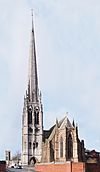 |
This Roman Catholic church was designed by Joseph Hansom, the inventor of the Hansom cab. Its spire is one of the tallest in England, standing at 94 metres (309 feet). The main church is built of sandstone, but the tall steeple is made of limestone. |
| St Wilfrid | Ribchester 53°48′37″N 2°32′00″W / 53.8103°N 2.5332°W |
 |
Dating from the 1200s, this church has a pulpit from 1636 and box pews from the 1700s. A chapel inside has a wall painting of Saint Christopher from the 1300s or 1400s. The chapel's window also contains pieces of medieval stained glass. |
| St Michael | St Michael's on Wyre 53°51′46″N 2°49′10″W / 53.8628°N 2.8195°W |
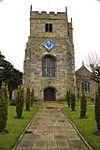 |
This church is mostly from the 1400s, with a wide tower likely built in 1549. Inside, a wall painting from the 1300s shows the Ascension. A chapel on the north side, founded in 1480, contains stained glass from the 1300s. |
| St Leonard the Less | Samlesbury 53°46′05″N 2°37′25″W / 53.7680°N 2.6237°W |
 |
Rebuilt in 1558, this church has some parts from the late 1100s. The south porches are made with timber frames. Inside are box pews from the 1600s and 1700s. A suit of armour on display is believed to have belonged to Thomas Southworth of nearby Samlesbury Hall. |
| St Andrew | Slaidburn 53°57′51″N 2°26′36″W / 53.9642°N 2.4434°W |
 |
This church from the 1400s is known for its high-quality woodwork. It has pews from the 1600s and 1700s. It also has a very unusual five-decker pulpit from the 1700s, which is much taller than a normal pulpit. |
| St Saviour | Stydd 53°49′08″N 2°31′38″W / 53.8189°N 2.5273°W |
 |
This simple, rectangular church is the only remaining building from a group owned by the Knights Hospitaller in the late 1200s. It has Norman windows in the north wall and an Early English style doorway in the south wall. |
| St John the Baptist | Tunstall 54°09′35″N 2°35′32″W / 54.1597°N 2.5923°W |
 |
While most of this church is from the 1400s, its oldest parts date to the 1200s. It is built from sandstone and has a two-story south porch. Inside, the church has preserved a real altar from the time of the Romans. |
| St Thomas the Martyr | Upholland 53°32′26″N 2°43′16″W / 53.5405°N 2.7211°W |
 |
The main part of this church was originally the east end of a Benedictine priory (a type of monastery) founded in 1319. The tower was added in the 1400s. Steps on the north side lead down to a crypt (an underground room) that is now used as a vestry. |
| St Mary and All Saints | Whalley 53°49′16″N 2°24′28″W / 53.8212°N 2.4077°W |
 |
This church from the 1200s has a Norman doorway and fragments of Anglo-Saxon carvings. It is famous for its amazing wooden furniture. The choir stalls, from the 1400s, were moved here from the old Whalley Abbey. They have intricate canopies and misericords. |

